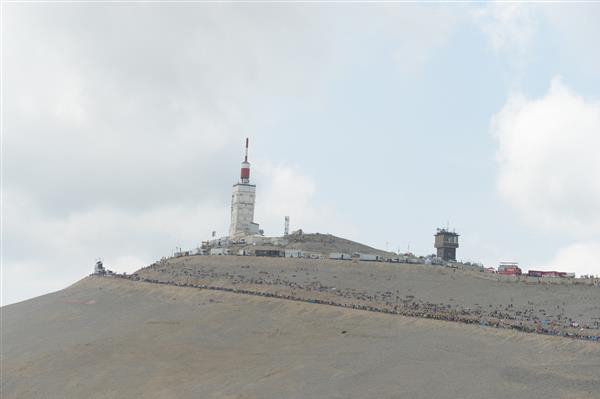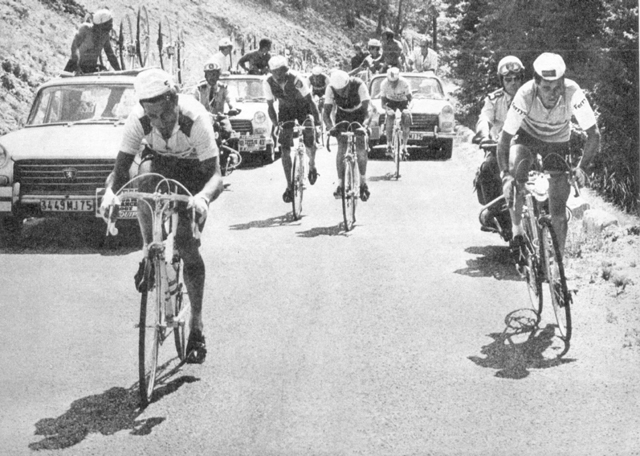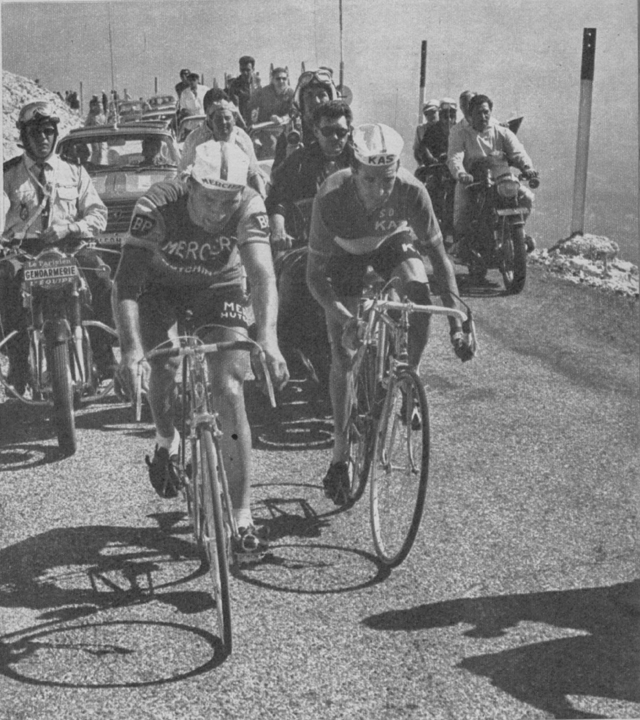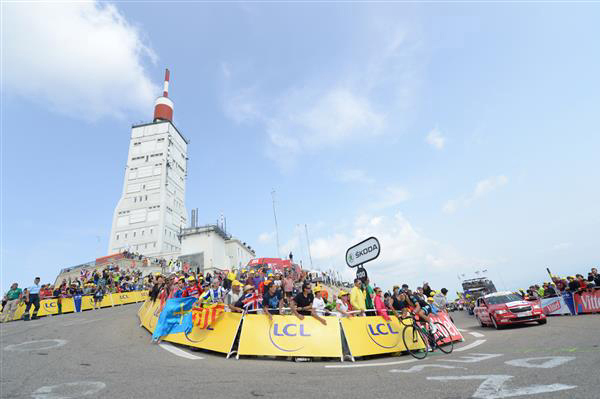Mont Ventoux
Its cycling history, statistics, photos and map
Statistics | Mont Ventoux in cycling history | Photos | Map |
Back to KOM French climbs | Back to KOM index page
Nicknamed "The Giant of Provence", Mont Ventoux is part of the French Alps. Because it's by far the highest mountain in the area, it can be seen from far away. It's top is bare limestone, devoid of trees. Especially above the treeline it can be blisteringly hot in the summer. Moreover, winds of 90 km/hr blow 240 days of the year, and winds have been clocked as high as 320 km/hr.
Because it's by far the highest mountain in the area, it can be seen from far away. It's top is bare limestone, devoid of trees. Especially above the treeline it can be blisteringly hot in the summer. Moreover, winds of 90 km/hr blow 240 days of the year, and winds have been clocked as high as 320 km/hr.
There are three routes to the top of Mont Ventoux, from Bédoin, Malaucène and Sault (generally considered the least demanding route). I've used the statistics for the road from Bédoin since that's the route the Tour de France usually uses:
Average Gradient 7.6%
Maximum
gradient 12%
Length of climb: 21.4 km
Elevation at start 383 meters
Elevation at crest 1,912 meters
Mont Ventoux in cycling history
The Tour de France first ascended Mt Ventoux in 1951 (where it came from the Malaucène side) but wasn't used as a hilltop finish until 1958 in stage 18. Unsurprisingly, eventual 1958 Tour de France overall winner Charly Gaul won the stage.
Mont Ventoux etched itself in cycling history when British rider Tom Simpson died near the top in the 1967 Tour de France. His death was attributed to a combination of dehydration from the day's extraordinary heat, a case of diarrhea, lack of available water, amphetamines and alcohol. Near the top there is a memorial to Tom Simpson.
Eddy Merckx didn't think racing up Mont Ventoux in the 1970 Tour would be anything special, but he was in such rough shape after winning the stage he was given oxygen.
Marco Pantani broke away on Mont Ventoux in stage 12 of the 2000 Tour de France. Armstrong bridged to the Italian and then eased slightly to let Pantani take the stage. This is the usual practice among professionals. The GC contender, content with the time gain, lets his fellow breakaway rider take the stage. But Armstrong, in an ill-mannered move, told the press he had let Pantani win. Pantani, always insecure, was humiliated and several times launched suicidal attacks in the mountains aimed at Armstrong.
In the 2013 Tour, after four rated climbs, the top of Mont Ventoux was the finish of the year's longest stage. Overall 2013 Tour winner Christopher Froome executed a dominating ride, confirming his status as the best rider in the race.
The fastest fifteen recorded times for a Mt. Ventoux ascent are all before the UCI's imposition of the biological passport in 2008. The reader can draw his own conclusions. The fastest known ascent was by Iban Mayo in the 2004 Critérium du Dauphiné Libéré. He did the Bédoin ascent in 55min 51sec. Charly Gaul's 1958 time was 1hr 2min.
Our mountain cycling expert Larry Theobald of CycleItalia cycling tours remembers:
"One word comes to mind when recalling Mt. Ventoux—HOT. I was there in Carpentras in 1994 when Eros Poli was the winner of stage 15, as well as tackling the Giant of Provence on my own bicycle back in 1991. Every time I've been in this region of France it's been insanely hot.
"The climb itself, with a length of almost 22 kms at an average grade of 7.6% is challenging enough, but the heat is what really gets to you, especially when you come out of the trees onto the stark 'moonscape'. It's easy to understand how Tom Simpson could have died on this climb—it's one I'm happy to say 'been there, done that'.
"The DESCENT on the other hand, is big-time fun. We had a great time playing draft and pass on the way down, one of the guys with us even doing a BigMig imitation, almost missing a corner and putting his foot down. One must be careful with the swirling winds, you can find yourself being banked over for a corner and suddenly being 'stood up' by a wind blast!"
Mont Ventoux Photos:

The exposed limestone summit of Mont Ventoux.

Louison Bobet climbing Mont Ventoux past the tree line in stage 11 of the 1955 Tour de France, which Bobet won.

Tom Simpson (left) in crisis as he ascends Mont Ventoux in 1967.

Raymond Poulidor and Julio Jiménez ascend Mont Ventoux in stage 14 of the 1965 Tour. Poulidor won the stage, Felice Gimondi won the Tour.

Marco Pantani crosses the line first in stage 12 of the 2000 Tour de France. Armstrong would later say he let Pantani win.

Richie Port near the summit in stage 15 of the 2013 Tour. The photographer's fisheye lens is distorting this. Porte is not riding downhill here!
Map:

Map of Mont Ventoux. It's treeless limestone cap can be clearly seen.The southern road out of Bédoin leads to Carpentras. Malaucène is on the center of the right side. Sault can't be seen, but it's to the southeast of the mountain.
Back to KOM French climbs | Back to KOM index page







